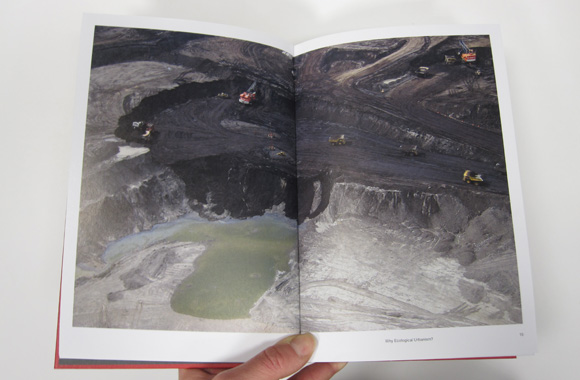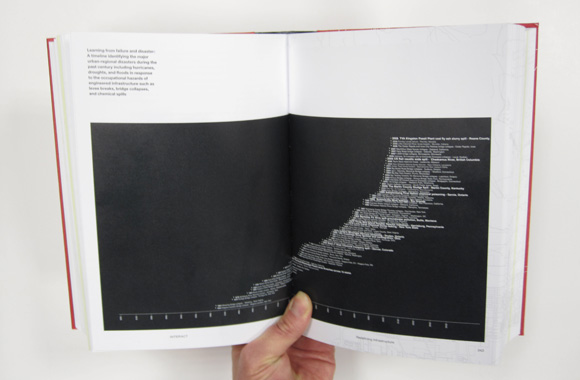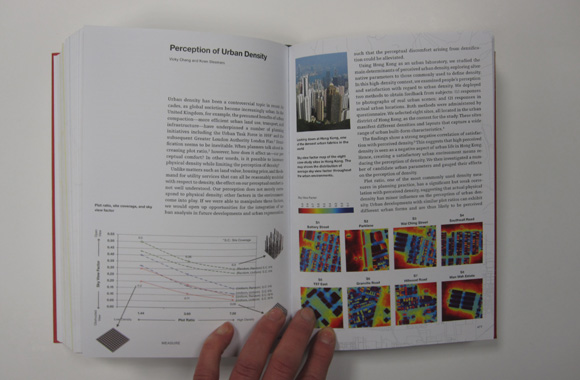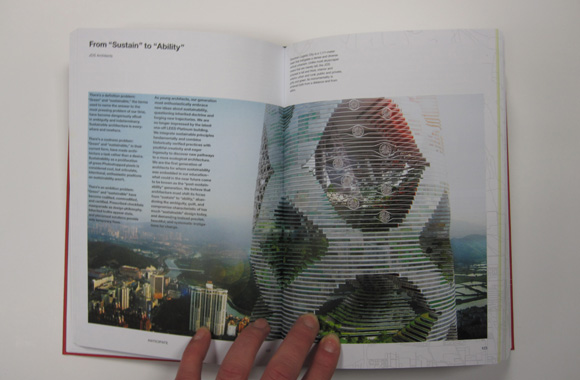We kick of with a introductory review of the recent Harvard publication 'Ecological Urbanism' edited by Mohsen Mostafavi with Gareth Doherty, published by Lars Mueller Publishers. This will provide the context in terms of topics and problems for the following discussion.
---
The book sprung from a conference held in April 2009 at Harvard University - Graduate School of Design, titled "ECOLOGICAL URBANISM: Alternative and Sustainable Cities of the Future". Design practitioners and theorists, economists, engineers, environmental scientists, politicians and public health specialists where invited to discuss and compare ideas, projects and latest developments about the present and future of ecological urbanism.
The book foreword by Mohsen Mostafavi is concise and yet rich of insights. His words may be interpreted as an axiom made by three simple statements which bring the reader to a notorious conundrum. The articles in the book (hopefully) should help the reader decipher it.
Statement 1: The largest wave of urban growth in history is happening now. Since 2007, for the first time, the majority of the world’s population has been living in urban instead than rural areas (UN-Habitat, 2007). Rapid city growth is often uncontrolled and risky.
According to Roy (2009) by 2025 more than 90% of the new urbanites will locate in developing countries (UNFPA, 2007), which are already characterised by explosive growth of population, low stages of economic development and poor state of environment (Pugh, 2000).
Statement 2: The former leads to a massive use of the available resources and the necessity to address scarcity. In fact, cities cover only 2% of the earth’s surface, yet consume 75% of all resources and produce 75% of all waste (UNFPA, 2007).
Megalopoleis have captured much of the public attention, but most of the new growth will occur in smaller towns and cities, which have fewer resources to respond to the magnitude of change.

Image taken from Ecological Urbanism / Spread from the book.
Statement 3: The former two lead to environment exploitation and consequent disasters, especially around urban areas. Urban sprawl fragments land cover, reducing ecosystem functions and increasing the probability of natural and man-made hazards.
The conundrum is thus the following: can we achieve fast urban growth and development without destroying the Earth?
As Bruno Latour outline in his article, “nothing looks the same, space is different, and so is time. Space is now that of a fully urbanized planet Earth.” So, where and how will we learn our new skills?

Image taken from Ecological Urbanism / Spread from the book - a timeline identifying the major urban-regional disasters during the past century.
Architecture, in the broader sense of the word, should be able to address this issue and give some answers. Unfortunately true scientific research concerning sustainable urban growth, large-scale planning and related ecological disasters has just started with very low and uncoordinated funding.
Most of the current research is towards architectural solutions and building products which bring new technological insights to the problem at a small scale, but do not break into the large scale issues.
The book shows exactly these limits within the architectural world. Theoretical advances in urban ecology and the state of the art of design concepts and practices are beautiful illustrated within the 655 pages of the volume. However, most of the projects have very limited scientific significance and minimal impact on a large scale.
The key to address the conundrum seems to be “density”, since it relates and affects each and every subject within the book. Density is the factor that puts in relation humans to city scale, therefore reflecting the soul of both. Density might be the only factor that can have a remarkable impact on sustainability both on large and small scale. Can we define a socially and morphologically “right density”? What kind of urban visions would that bring?

Image taken from Ecological Urbanism / Spread from the book - Perception of Urban Density.
These questions cannot be answered by high-tech solutions or visionary projects, since the places that need the answers the most are still developing in a conventional and conservative way with low resources and increasing fragility.
According to Mostafavi, we need to view this fragility as an opportunity to define a new sensible approach to urbanism, the one that identifies “right densities”, drivers and constraints. The city is not anymore the modernist machine, that works as an entirety in every given world location. Instead, as an organism, the contemporary city evolves through ecologies of social interaction and the natural and built environment (e.g. Felix Guattari’s “ecosophy” concept).
Nowadays, sustainability is a philosophy rather than a design ability, forging a new international language. In architecture history there's always been a need to find a common, widespread and recognizable language. Whether we trace it back to the Gothic Style or more recently to the Modern Movement, whether it is the result of aesthetics forgery or organised agendas it does not make a difference: cities has been shaped and developed by following trends and styles.
Ecology and sustainability have become today the new widespread language, suddenly (and finally) a fashionable one, which might bring architects, city planners and scientists together working towards the same goal. Whether they will be successful it will depend on the ability to coordinate appealing projects with true scientific background, the capacity of translating international concepts into simple and local words of action.

Image taken from Ecological Urbanism / Spread from the book - From "Sustain" to "Ability".
In order to extend this debate towards a better understanding of cities as organisms shaped by local actions and ecological patterns, several invited guests will contribute to the discussion over the next days. They will be, in order of appearance: Duncan Smith, Luis Suarez, DPR-Barcelona, Annick Labecca, Martin John Callanan, Stanza, Kiril Stanilov contribuiting on the following subject areas:
1. Environmental and Socio-Economic Contexts
2. Visionary Projects
3. City Sensing
4. Urban Morphology
References:
Roy, M (2009) Planning for sustainable urbanisation in fast growing cities: Mitigation and
adaptation issues addressed in Dhaka, Bangladesh. Habitat International 33 (2009)
pp. 276-286.
Pugh, C. (Ed.). (2000). Sustainable cities in developing countries. London: Earthscan.
UNFPA (United Nations Population Fund). (2007). State of world population 2007.
UN-Habitat (2007). Global Report on Human Settlements 2009: Revisiting Urban Planning,
outline, UN-Habitat Global Reports on Human Settlements, New York: United Nations
This Guest post by Taneha Bacchin forms part of the discussion in the single-blogs series on Ecological Urbanism.
Mostafavi, M., Doherty, G. & Design, H.U.G.S.O., 2010. Ecological Urbanism, Lars Muller Publishers.
---
Contributors to the following discussion are in the order of appearance:
Taneha Bacchin is a PhD researcher at University College London - Centre for Advanced Spatial Analysis, UK. She holds a Doctoral Fellowship sponsored by CAPES / Brazilian Ministry of Education for modeling the "co-evolution of cities and environmental crisis".
Architect and urban planner (MArch) graduated with honour at IUAV University of Venice, Italy (2006) and MSc. in Spatial Planning & GIS at IUAV, Italy (2009). During her studies in Brazil, she has worked as a research assistant in urban planning and computation sponsored by CNPq / Brazilian Ministry of Science and Technology.
Since1996 she has worked in architectural and planning practices in Brazil, Italy and Denmark. At the IUAV University of Venice, she has been tutor for the BArch Final International Laboratory.
Duncan Smith, is a researcher in GIS and urban geography at CASA UCL, completing a PhD on the topic of polycentric urban form and sustainable development. He also works as a research fellow at the Greater London Authority Economics Unit.
Luis Suarez was born, in Bogotá, Colombia and graduated from The University of Florida in design, construction and planning in 2005. He received a master in science of urban design from The Bartlett School of Architecture, University College London. He is currently pursuing a Masters in Bioclimatic Architecture from The Isthmus School of Architecture for Latin America and the Caribbean. He is designing and building multiple projects in South and Central America with his established firm, Estudio ArQ.
dpr-barcelona is a young and independent publishing company based in Barcelona, specialized in high quality architecture and design books. Focused on the work of emerging architects and designers and their innovative projects. With an international scope and founded by two architects, all of dpr_editorial books are product of a creative exchange between publisher, author and designer and with the collaboration of some experts that make most complete the overview about each project.
Annick Labeca is a researcher on Japanese cities based between Paris and Tôkyô. She has a deep interest on typomorphology and morphogenetic architecture.
Martin John Callanan is an artist and researcher exploring notions of citizenship within the globally connected world. Concerns include information, data, and knowledge.
Martin John Callanan is an artist whose work spans numerous mediums and engages both emerging and commonplace technology. His work has included translating active communication data into music; freezing in time the earth’s water system; writing thousands of letters; capturing newspapers from around the world as they are published; taming wind onto the internet and broadcasting his precise physical location live for over two years.
Stanza is an internationally recognised artist, who has been exhibiting worldwide since 1984. His artworks have won prestigious painting prizes and ten first prize art awards including:- Vidalife 6.0 First Prize. SeNef Grand Prix. Videobrasil First Prize. Stanzas art has also been rewarded with a prestigious Nesta Dreamtime Award, an Arts Humanities Creative Fellowship and a Clarks bursary award. His mediums include; painting, video, prints, generative artworks and installations. Stanza is an expert in arts technology, CCTV, online networks, touch screens, environmental sensors, and interactive artworks. Recurring themes throughout his career include, the urban landscape, surveillance culture and alienation in the city.
Kiril Stanilov holds a Professional Diploma in Architecture from the University of Architecture, Civil Engineering and Geodesy, Sofia; a Master of Community Planning from the University of Cincinnati; and a PhD in Urban Design and Planning from the University of Washington. From 1998 to 2008 he was an Assistant and an Associate Professor in Planning at the University of Cincinnati where he taught courses in urban design, physical planning, and contemporary urbanization.
Kiril Stanilov’s research interests are centered on explorations of contemporary patterns of urban growth and change, and the role played by public policies in shaping urban form transformations.
Tidak ada komentar:
Posting Komentar